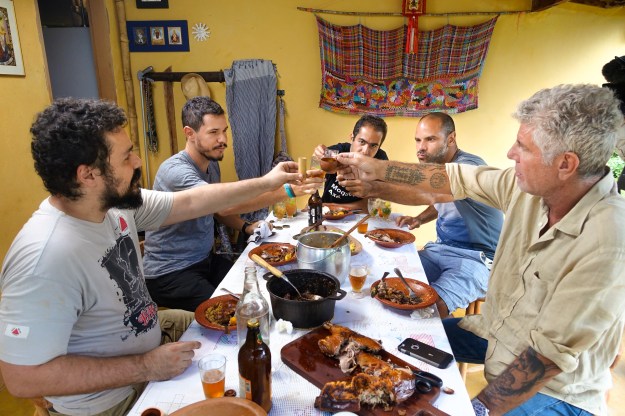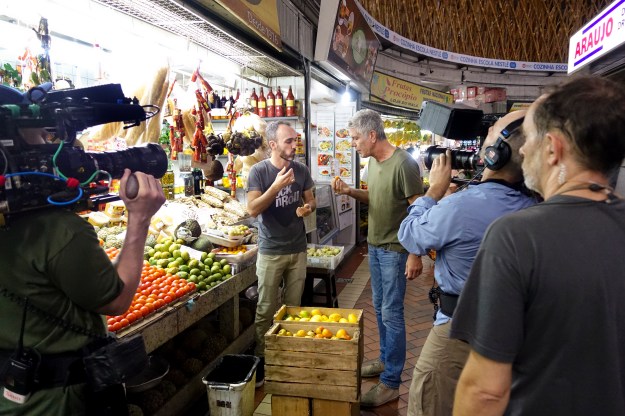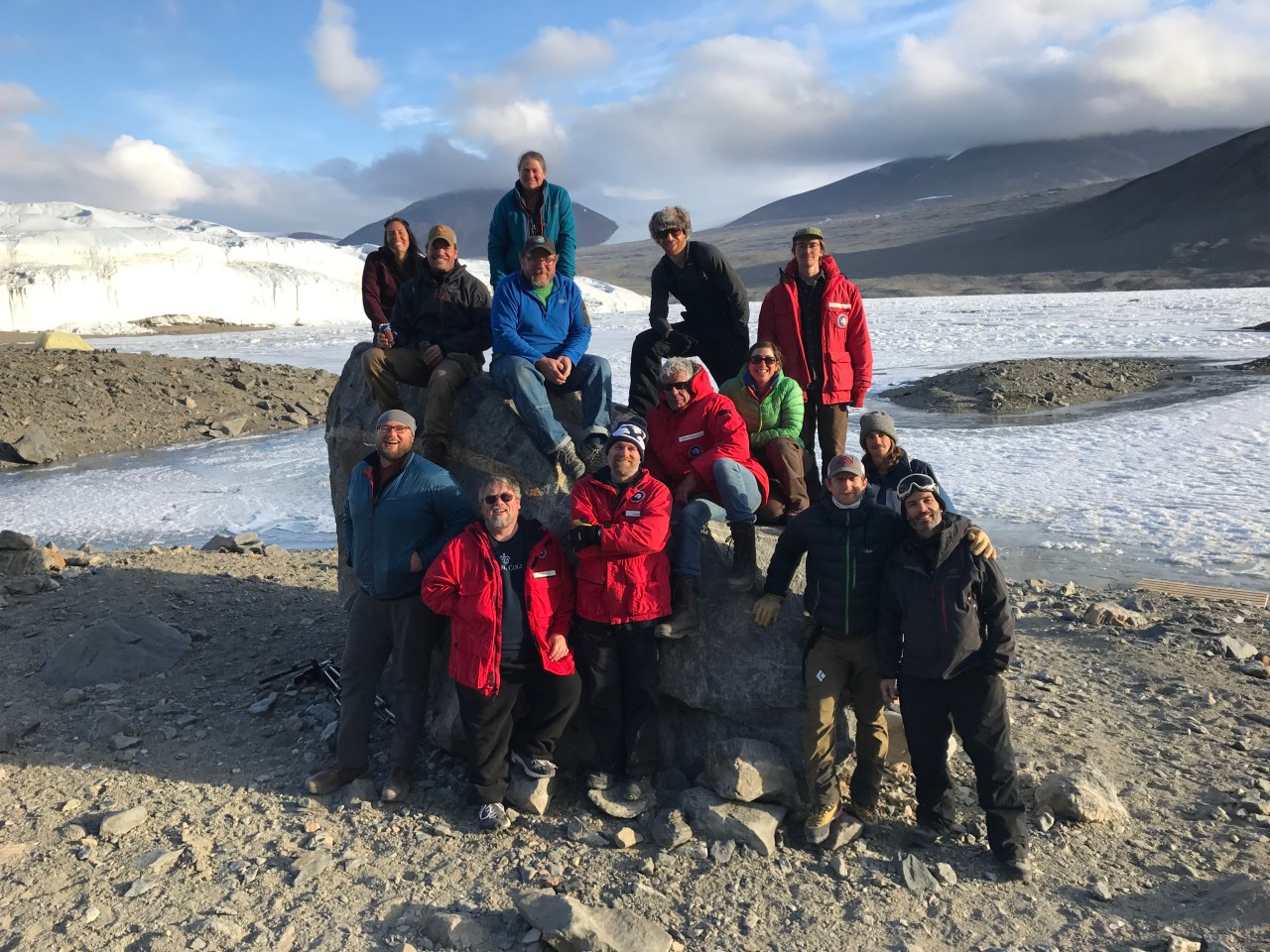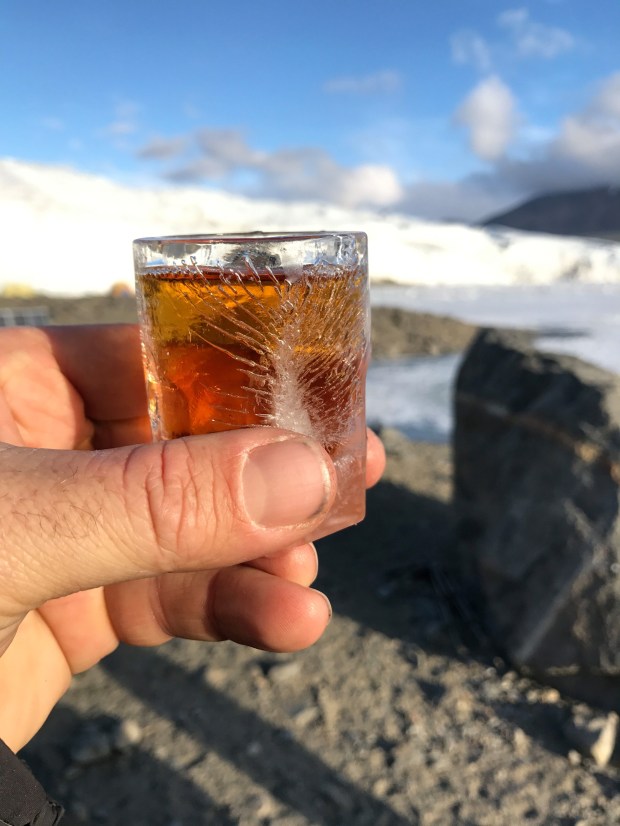I was in my usual position, standing behind the camera. In front of me, Tony sat with four great Brazilian chefs. We were in the inland state of Minas Gerais, which is known for creating some of the best food in the country.
We were on a family farm that sat high in the mountains between the gilded city of Ouro Preto and the state capital, Belo Horizonte. These were the mountains from which West African slaves, under the knife of the Portuguese empire, had pulled billions of dollars in alluvial gold (the name Minas refers to the mines). While those Portuguese masters fanned their lazy asses on the riversides, and the West Africans worked their asses off in the mud, the abhorrent dynamics of conquest had inadvertently pulled three unlikely culinary elements together: Portuguese technique and livestock, West African cooking and cuisine, and the distinctive native ingredients of Brazil.
This trifecta had melded over time into one of the great, and still relatively unknown, cuisines of the world. This farm where we stood at that moment could be said to be the very nexus of that cuisine and history.
The chefs eating with Tony were at the top of their game. They had spent their lives mastering that food—their food—that their grandmothers and their grandmothers’ grandmothers had passed down. They now eagerly put forth a feast which, for many, would be the meal of a lifetime.
For Tony, and for those of us lucky enough to have been pulled into his gravitational field, it was one of many such meals. Meals that hundreds of people—from farmers to world-class chefs to street stall owners and families—had prepared for us, all with the same eager desire to share themselves and their world with Tony (and his audience) for nearly two decades.


For 10 lucky years, I traveled with Tony to almost 60 countries on seven continents. During that time I got to travel with the best possible company that one could imagine: not only Tony, who was the dream travel companion for millions of viewers, but the crew, our crew, who are the finest people I have known. They are family.
During that meal in Minas, the chefs were discussing what made a good meal, and Tony said, “Meals are made of three elements: the food, the environment, and the company. If the food sucks and the environment is great, or the environment sucks but the food is amazing, or both suck and the company is great, that all works… But if the company sucks, no matter how amazing the other elements, you’re screwed.”
I think about that a lot now. When I was traveling and eating with Tony and the crew, the company was never an issue—it was always good. I can’t remember a truly s***ty meal because we were all together.
The meals I had on the road with Tony have become the mile markers on a long journey that has fundamentally changed everything about how I see the world, its people, and myself. They were part of an extraordinary and singular adventure that this kid from a small town in New Hampshire got to be a part of. Now, I write, through tears, as I try desperately, mostly futilely, to understand and reconcile what happened to my friend, mentor, and hero.
I first met Tony in a small restaurant in Cairo. At the time, I knew of Tony and had seen a couple of episodes of No Reservations, but I didn’t really know what it was all about. But I had worked for Zero Point Zero, Tony’s longtime production partners, on another show and knew what a rare and wonderful gem they were. I jumped at the opportunity.
During the first few days of the shoot, we didn’t interact much. The team had been together for a while, and there was definitely a bit of a Who the f*** is the new guy vibe. Tony, for his part, had no idea who I was or how the hell I had ended up there.
Toward the end of the shoot, we headed out to the desert in a pair of 1970s-model Land Cruisers. We would, of course, need shots of our cars crossing into the vast and empty space, so I volunteered to ride atop one of the vehicles. The four-post bed that was inexplicably tied to the roof seemed a safe enough perch for a mellow drive across the soft, sandy, forgiving landscape, and our gentle-looking Bedouin drivers seemed like pros. I jumped atop the bed and hoped the thirty-year-old roof rack would hold.
A few minutes later I was clinging to the bed the way a flimsy roof shingle tries to hang on in a tornado. We were crossing the sand so quickly that tears streaked across my temples. Egyptian music blasted unsympathetically from the cockpit as I attempted to hold the camera steady with one arm and wrapped the other around the bedpost. At 80 miles an hour, the soft, rolling sand had become a violent and wholly pissed-off, chattering death race.
I was clinging onto life and … I loved it.
My compatriots looked on in helpless amazement, and Tony was grinning ear to ear. As ill-conceived as the stunt was, it changed everything. We arrived at our destination, a Bedouin camp, and Tony walked up to me with a huge smile—and he knew my name! We laughed and marveled at the softball-sized hematoma that my death grip had left on my inner bicep. Tony never asked the crew to do anything overtly risky, but I think he understood and appreciated the rush that comes with pushing yourself the way I had.
We set into the work of the day. While some of the crew took Tony out into the sand to film some “deep thoughts,” I filmed the food prep. Our Bedouin host, Ahmed, was going all out: They were making whole goat, Halal of course, which meant using a clean, sharp knife; cutting quickly to minimize suffering; and pointing the animal’s head toward Mecca and most importantly doing so with respect for the life that was taken.
The goat was then skinned, butchered, and slathered head to toe in a thick paste of onion, cumin, garlic, and black pepper. Then it was buried in a 55-gallon drum in the sand with hot coals and left for a few hours.
The result was a soft, almost unspeakably tender, heavily spiced meat that fell off the bone. After we shot the meal scene, the crew sat around the fire and ate, bare feet in the sand, under the stars, a hundred miles from the nearest anything.
Ahmed and his friends played music, and Tony looked on, glassy-eyed, seemingly intoxicated by the journey. Later, we wandered off into the dunes. The moon was full, the sky was a velvety deep cobalt blue, and the night was cool. We smoked hash and stared up at the stars. I fell asleep, right there, in the sand, and in the morning, as I drank tea, I began to understand that this was so much more than a food show. It was about something much bigger—about people and places, near and far, and our common humanity.
And I was hooked.

Fast forward nine years. We had switched to CNN and were filming an episode of Parts Unknown in Antarctica. We reached the South Pole (Tony’s reaction? “It really is the ass end of the world,” he said as he walked away), visited the McMurdo Station research center, flew in the cockpits of C-130, the workhorse of the sky, sat with penguins, chased killer whales by helicopter—insane, once-in-a-lifetime stuff.
And then we visited the Dry Valleys. One of the driest spots in the world, the terrain is brown and sandy, and it looks like you’ve landed on Mars. Only a handful of people a year get to set foot there—and we were among the privileged few. We flew to the research camp at Lake Hoare in Dry Valleys, bearing pizzas for the scientists based there for the season.
The complex comprises a couple of buildings surrounded by tents that serve as the base camp for Dry Valleys researchers. While McMurdo feels a bit like a military compound, the main house at Lake Hoare is warm, homey, and welcoming. And the kitchen crew there cooks what is easily the best food on the continent.
We filmed Tony eating a feast of homemade bread, barbeque pork tenderloin, grilled mahi sticks, roasted beet salad—it goes on. After a little while, it was time to put the cameras down and have some fun. We broke into a bottle of Bulleit bourbon that we had squirreled away for this leg of the trip. We served it over ice that came directly from a nearby glacier, meaning that the bubbles that rose in our glasses had been trapped in the ice for more than 50,000 years.

We eventually moved the party to a nearby “beach”—a swath of sand that sits on the permanently frozen lake at the foot of the glacier. Tony, with a small Bluetooth speaker in hand, DJed, and “Gin and Juice” echoed across the lake. He sat back and had a rare look of contentment. As he leaned back, with a half-grin on his face, he seemed to be marveling at his creation. It was as though this whole endeavor—the entire show—was designed to create a few perfect moments like this one.
I woke up late the next morning and immediately jumped on a helicopter to shoot b-roll with Fred Menou (a cameraman) and Erik Osterholm (the episode director). Our pilot, a veteran who had done tours in Iraq and Afghanistan, showed us his favorite peaks—it remains, without question, my favorite day shooting for the series. For hours, we flew low through a twisting labyrinth of tight cliffs, revealing dramatic mesas with steep drops and valleys that could engulf the entire island of Manhattan. We flew over glaciers, endless sheets of ice that would cover greater Los Angeles. Stopping here and there to shoot I considered the fact that we might be the first living creatures to ever step out on some of these spots.
On our way back to the research station, we stopped at Marble Point, an isolated refueling station. When we arrived, three people came out to greet us: one was holding a slow cooker, another a pot of coffee. It was cold and windy, and we ate hot pulled pork sandwiches and drank coffee over a 55-gallon drum as they refilled the helicopter.
It may be my favorite meal of all time.